Best filter plugins 2025: We count down our favourite frequency shapers
Cut, boost, sweep, modulate and get creative with your frequencies
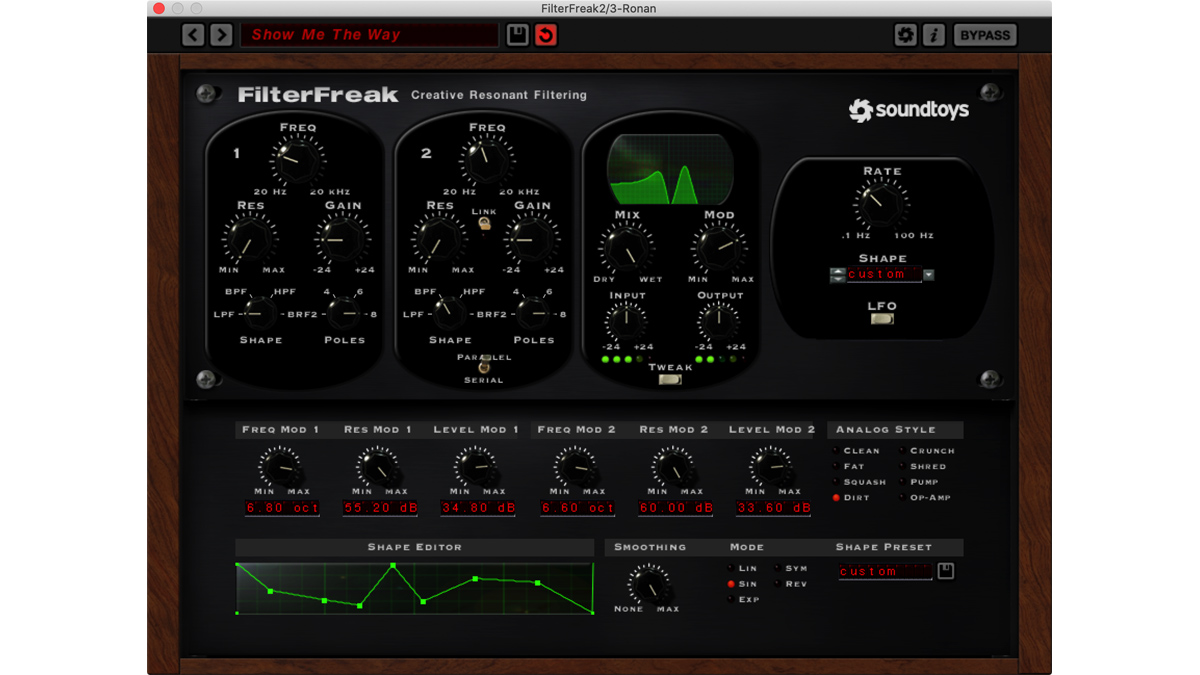
Filters can be the most dramatic effects in the modern producer's plugin arsenal, and these frequency shapers are often the go-to tools for contemporary dance and electronic music producers. Their striking processors can be dynamic and evolving, can usually be sync'd to BPM, and often also introduce other effects like saturation and delays, all controlled with sophisticated modulation options. In this buyer's guide, we round up the best filter plugins on the market so you can enjoy the most creative effects used in music production today.
In many ways, today's filters cross over with EQs because, on a basic level, a filter allows some frequencies through but not others, and also enhances particular frequencies.
However, filters take frequency manipulation up a notch (pun intended). They almost always feature extra modulation elements, so you can use LFOs, envelopes and sequencer control to alter the filter’s frequency, resonance and other parameters, resulting in effects that move, swirl and evolve as your music plays.
They also usually feature many more filter types than your average EQ, so can transform the character of a sound either subtly or dramatically.
With extreme modulation, then, a filter is like an EQ on steroids. This being the case, filters tend to be used more creatively than EQ plugins. If you want more surgical control over your frequencies, or perhaps a plugin to use just as a mix processor, then check out our best EQ plugins.
Here, though, we're focussing on the best 10 filter plugins. Our selections span a wide range of price points and potential creative uses, from adding a warm and natural classic sound through creating filter sweeps for dance music right up to creating wild, dynamic and evolving frequency effects.
At the end of this guide we have a buying advice section that tells you more about filters and their different types, so if you want a fuller skinny, skip to the end. First, though, we present our absolute favourite filters from our buyer's guide and detail the full top 10.
Looking to make music software savings this Black Friday? Shop our handpicked selection of the best Black Friday plugin deals.
Best filter plugins: MusicRadar's Choice
For this best filter plugins guide, we are talking extreme frequency manipulation, and the best of our list includes some old favourites and one or two newcomers to the filter scene.
Incredibly, after so many years at the top, both Soundtoys FilterFreak and Fabfilter Volcano still cut through a mix like hot filtered knives through butter. With amazing modulation features that include step sequencers, envelopes, X-Y pads and more as sources, and just about anything else as destinations, both plugins have been updated to keep abreast of and even exceed the competition and are still great buys.
UVI's Shade is a more recent release and also delivers a huge amount of modulation, and probably has the edge for sheer number of filter types and modern production features.
It's fair to say that most other filters in our buyer's guide deliver the modulation goods, too, but if you want something a little different from that swirling sonic mass of dynamic frequencies, then Arturia's 3 Filters You Will Actually Use has three classic synth filters for a decent price. Less about crazy effects and more about delivering a classic, vintage sound, you get (almost) three for the price of one.
And finally, if it's vocal filter effects you’re after, then Audiothing's The Orb delivers formant filtering in spades, and all behind a lovely UI.
Best filter plugins: Product guide
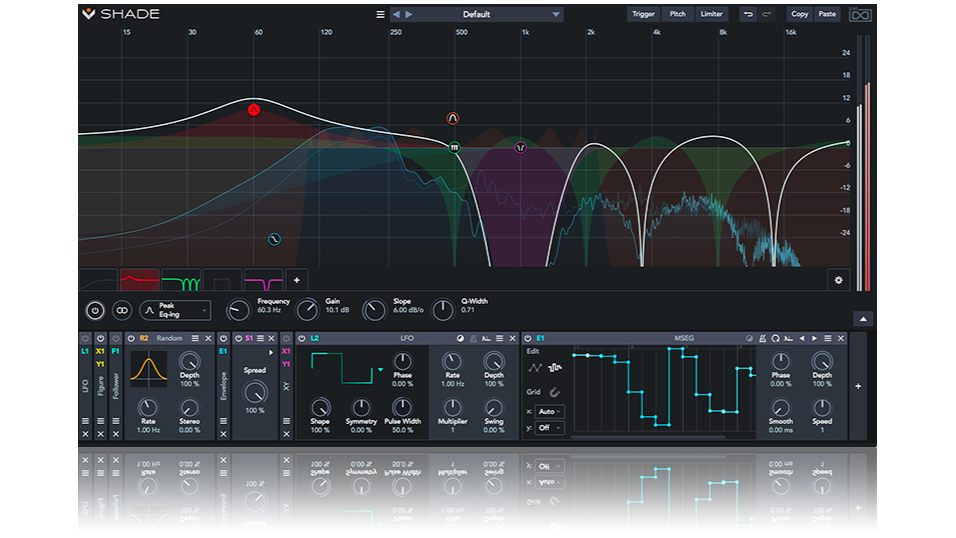
Specifications
Reasons to buy
Reasons to avoid
You might have heard that Shade is just an EQ, but it's so much more than that, and its creative filtering features end up stealing the headlines.
As an EQ it has potentially unlimited bands and a whopping 35 filter shapes that range from regular peak, shelving and high/low-pass to more exotic comb and resonant notch filters.
However, Shade also features nine modulators that can be used to control multiple targets, including EQ parameters. This transforms Shade into a more creative EQ and filter that delivers dynamic, moving and animated effects. Typical modulators such as syncable, adjustable LFOs and regular DAHD envelopes are joined by more complex examples such as a multi-step envelope generator (MSEG), a Random Generator and a Signal Follower.
It’s easy to get wrapped up in Shade’s awesome flexibility; it’s an impressive creative tool and also one that’s hard to leave alone once you get started. In other words, it’s exactly what we want from a next-generation EQ and filter - a truly wonderful plugin.
Read the full UVI Shade review
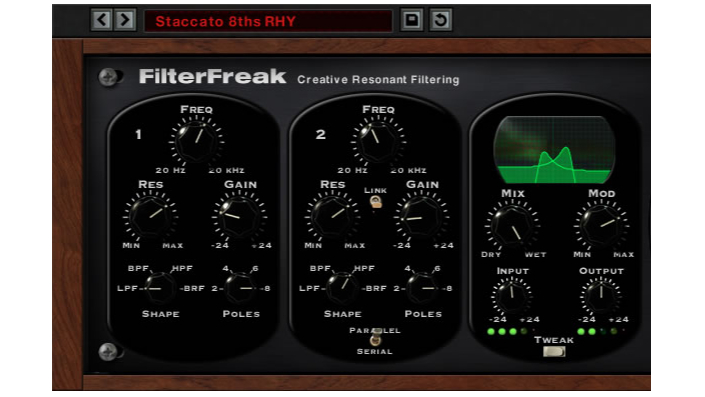
2. Soundtoys FilterFreak 2
Our expert review:
Specifications
Reasons to buy
Reasons to avoid
Ask any professional audio engineer to name their top three software effects and there's a high chance that at least one from Soundtoys' extensive range of analogue-flavoured plugins will make the list. And if that engineer happens to specialise in dance music, it's equally likely that their specific selection will be the amazing FilterFreak.
Emulating a variety of legendary hardware filters - including the Mutronics Mutron and Sherman Filterbank - and incorporating a powerful modulation system with step sequencing, FilterFreak is as musical and versatile a filter as you could hope to find.
Capable of all manner of phasing, bouncing and mangling antics, there’s something really organic and vintage about FilterFreak’s tone. And while it might have been around for longer than most other filters in our buyer's guide, this unique character and sound, plus the dynamic sonic results it is capable of, still give FilterFreak the edge.
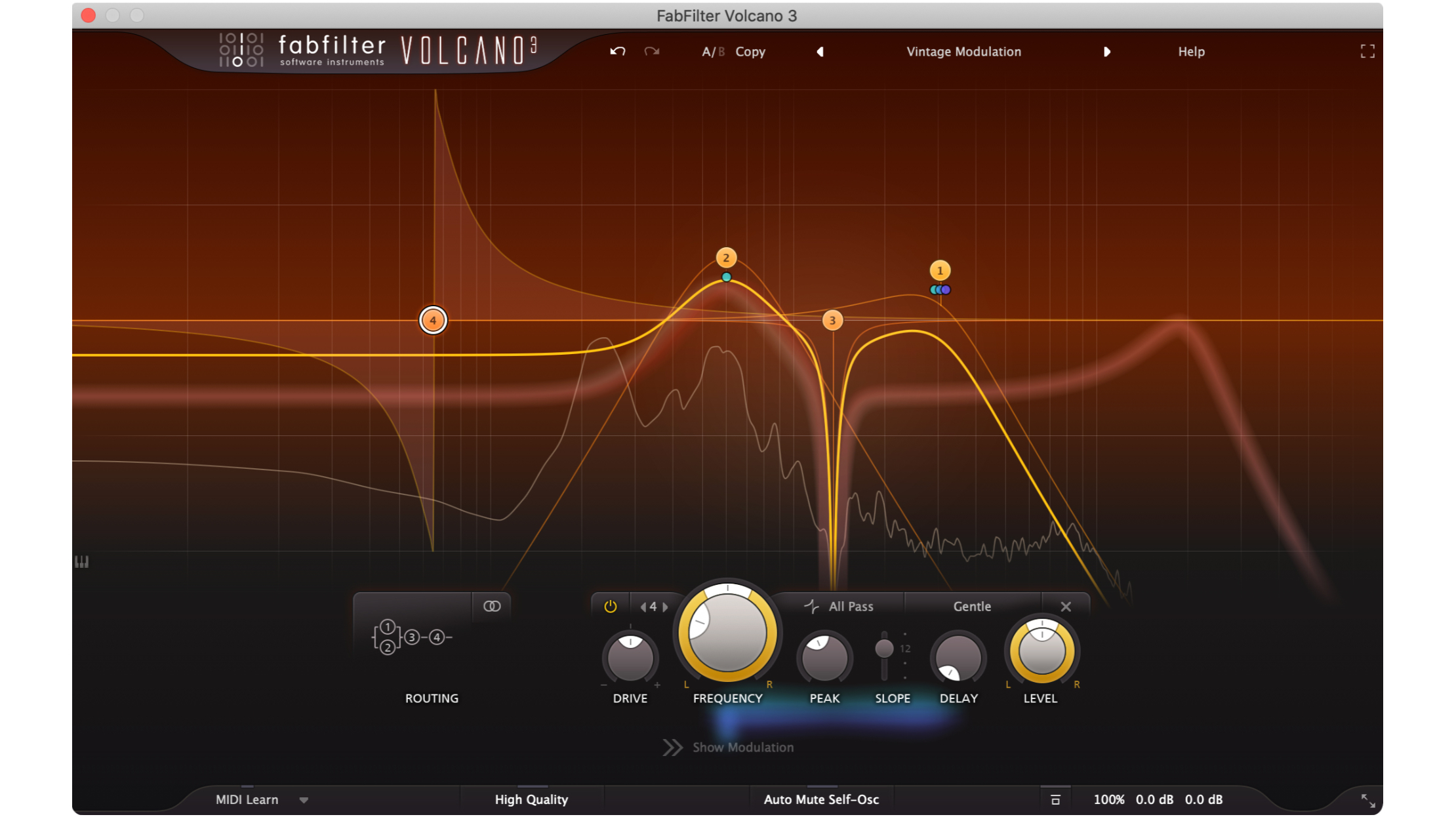
3. FabFilter Volcano 3
Our expert review:
Specifications
Reasons to buy
Reasons to avoid
Incredibly, Volcano has been spewing forth its incredible filter sonics since 2005. At its core you get four multimode filters which can work as everything from standard low-, band- or high-pass types to bell, low/high shelf, notch and all-pass.
You also get flexible routing modes including Stereo, where the signal is run through the four filters in series; Left/Right, where the left and right channels pass through independently configured filters; and Mid/Side, where the signal is split into mid and side components, each of which is filtered separately.
The modulation options are extensive, taking Volcano beyond what other filters in its class and price range offer. These include X-Y controllers, envelope followers and 16-step XLFOs. By applying a little know-how (or using the supplied presets), you can also go far beyond the usual resonant filter sweeps. It's easy to create anything from simple roll-offs to complex rhythmic effects and textures.
Volcano's sound is as slick as the graphics, and the broad range of options only sweetens the deal. With amazing sound and incredible flexibility, this is a must for anyone seeking a characterful all-in-one filter solution.
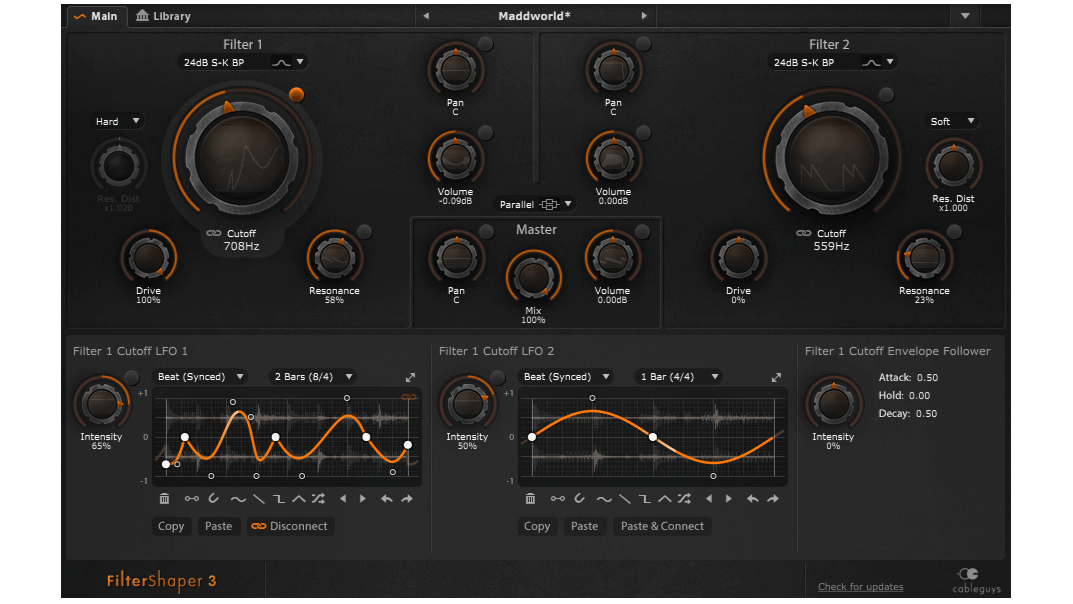
Specifications
Reasons to buy
Reasons to avoid
With its prominent pair of identical, multimode filters - which can run parallel or in series - FilterShaper is certainly capable of all the frequency boosting and attenuation that one would expect of a plugin with ‘filter’ in its name. But to think of it as ‘just a filter’ would be to miss the point.
FilterShaper 3 is all about modulation, with individual modulation sections for each of its main controls, each packing in a pair of LFOs and an envelope follower. Each LFO is fully editable, with a graphical editor enabling complex (or simple) waveshapes to be drawn. It all adds up to a bonkers frequency-sculpting plugin that can achieve mind-bogglingly intricate modulation.
FilterShaper 3 makes up for its standard-sounding filters with its amazing customisable LFOs and quick workflow. It’s fantastic for adding movement to music and anyone with a thirst for creative modulation needs to try it.
Read the full Cableguys FilterShaper 3 review
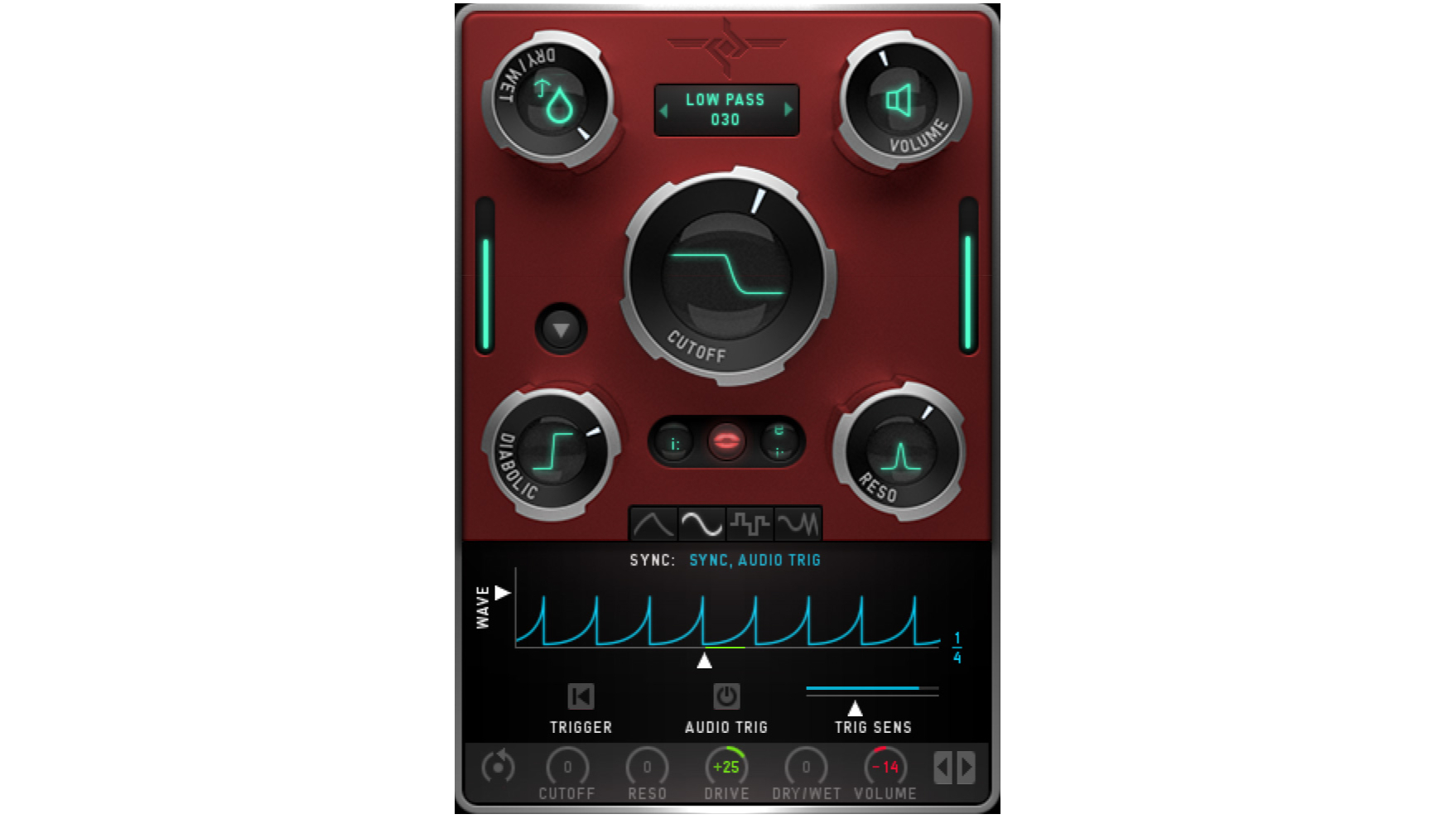
5. SugarBytes WOW2
Our expert review:
Specifications
Reasons to buy
Reasons to avoid
WOW2 is a filter and distortion plugin with plentiful creative options and outstanding sound quality. The distortion section offers seven distinct types, all of which are of incredibly high quality and can get pretty violent. You can also place the distortion module before or after the filter section, which greatly broadens the sonic range of the plugin beyond that of its predecessor. The filter type count stands at a mighty 21, ranging from natural and smooth to sharp and tearing.
One of the best things about WOW2 is its comprehensive modulation setup. There are four modulation sources onboard: an envelope follower, an LFO, a step sequencer and the 'wobble generator', an excellent tool for making wobbly filtered basslines.
WOW2 is definitely at its best used as a creative firecracker rather than a delicate, well-behaved precision filter – and when deployed as such, it’s an absolute ass-kicker and without doubt one of the best software filters money can buy.
Read the full SugarBytes WOW2 review
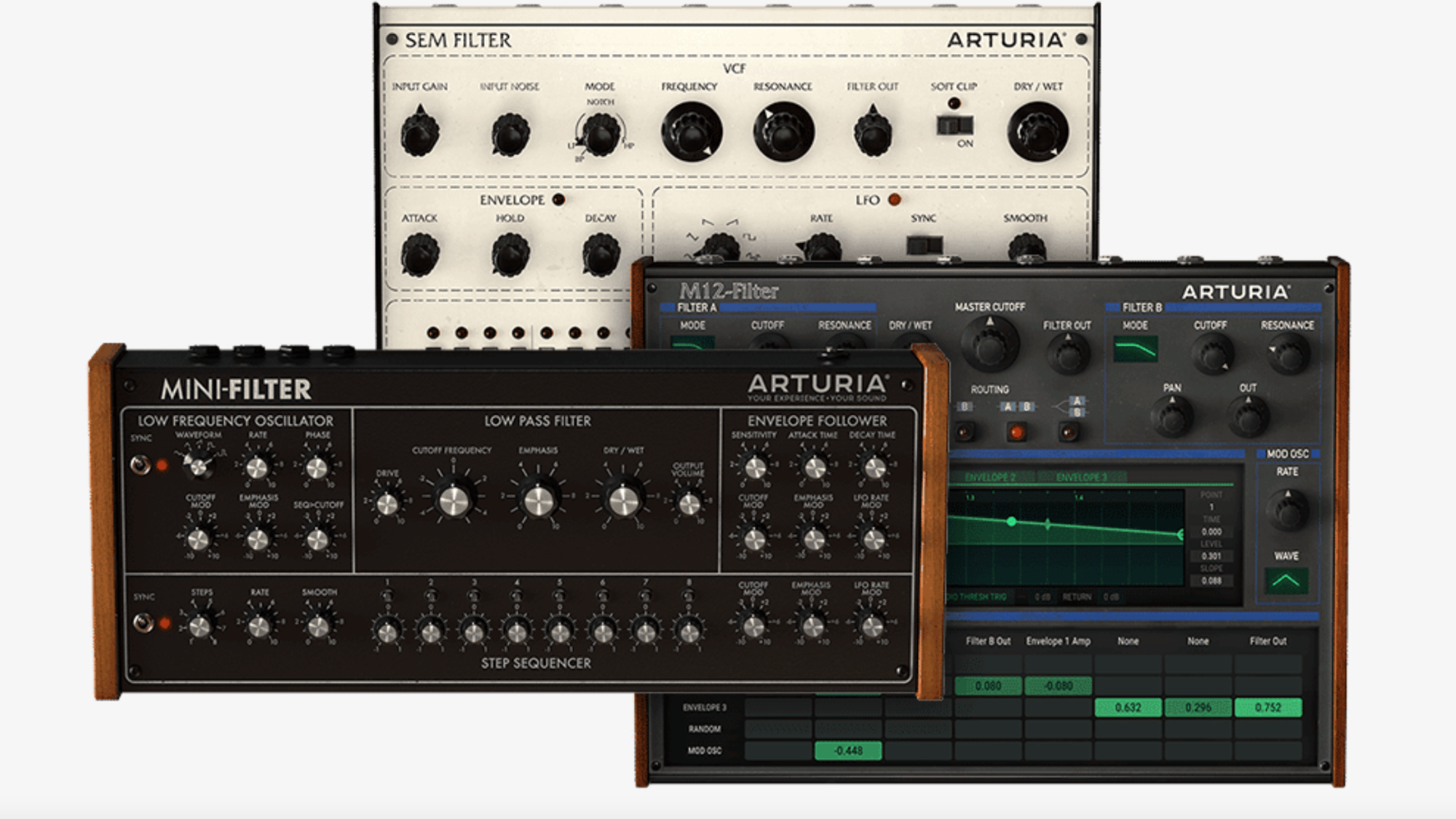
6. Arturia 3 Filters You’ll Actually Use
Our expert review:
Specifications
Reasons to buy
Reasons to avoid
There are three good reasons to include all three of these filters as individual entries in this filters buyer's guide, but the fact that you can buy them as part of Arturia's '3 Filters You Will Actually Use' bundle makes them an almost essential single purchase.
You get three iconic synth filters: Mini-Filter, from the Mini V Minimoog emulation; SEM-Filter, from the SEM V Oberheim SEM emulation; and M12-Filter, from the Matrix-12 V Oberheim Matrix 12 emulation. Each interface is designed and modelled on the original synth so you have three very distinct plugins.
Mini-Filter exudes all the warmth and fatness of the real thing, but goes further with its onboard LFO, step sequencer and envelope follower. SEM-Filter is smoother and less pronounced, particularly at high resonance, but it can still scream when you need it to, and is the more versatile of the two. By far the most flexible and feature-rich of the set, M12-Filter is a dual filter modulated by three powerful multi- breakpoint graphical envelopes.
Arturia’s trio of filters stands out in terms of hardware-inspired creativity and sonics.
Read the full Arturia 3 Filters You’ll Actually Use review
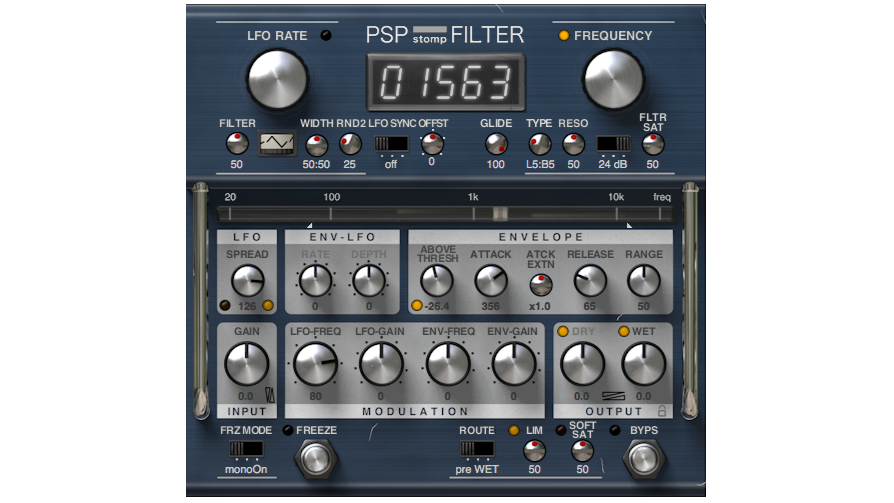
Specifications
Reasons to buy
Reasons to avoid
PSP stompFilter sports the same brand of handsome photorealistic fascia as its stablemate stompDelay, and is also built with modulation at the top of the agenda. Here it’s about filter cutoff as well as volume. The modulation signals are generated by an LFO and an envelope follower, or a combination of the two, between them enabling highly controlled rhythmic frequency shaping.
Although it might not appear in any way remarkable alongside comparable plugins of the same ilk, what gives stompFilter its edge is the superb quality of the filter itself - sharp, smooth, responsive and fluid - the deep LFO shaping options, and the Env/LFO cross-modulation setup.
Straightforward and intuitive in use, and smooth and musical in sound, it all adds up to a super-flexible effect for whipcrack filtering, funky auto-wah, auto-panning, pseudo-compression and more. This action-packed and endlessly creative frequency-shaping plugin delivers fabulous hardware-style filtering, both in the studio and on stage. A must-have!
Read the full PSP Audioware PSP stompFilter review
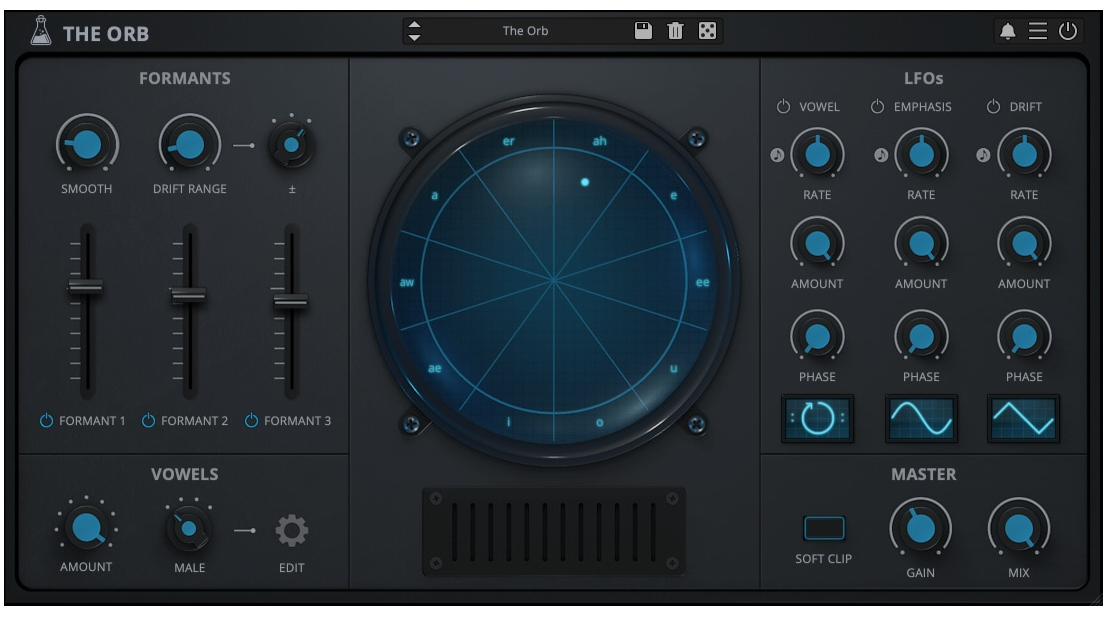
Specifications
Reasons to buy
Reasons to avoid
The Orb is a formant filter plugin built to imbue any source signal with a vowel-like sound, but going beyond the usual EDM ‘yoys’ we all know and love.
The ‘Orb’ at the centre of the interface hosts up to ten editable vowel filters at a time, while three LFOs jump and slide between them. This is where the actual filtering takes place, through movement of the little blue puck by dragging, modulation or host automation.
The formant filter itself comprises a trio of parallel zero delay feedback band-pass filters, their centre frequencies locked down for each vowel in Male, Female and Child modes, and editable in Custom mode. The distance of the Orb puck from the centre of the Orb determines the filter resonance (Emphasis), from sharp and fully vowel-like at the outer edge to sounding essentially like a regular band-pass filter at the centre.
Although certainly not a plugin you’ll want to use on everything, for spicing up drum loops, basslines (of the low-mid variety) and pads, The Orb is absolutely wicked, delivering everything from static tonal alteration to funky, highly animated vowel ‘sequencing’. It is a must-hear creative processor for any electronic music producer.
Read the full AudioThing The Orb review
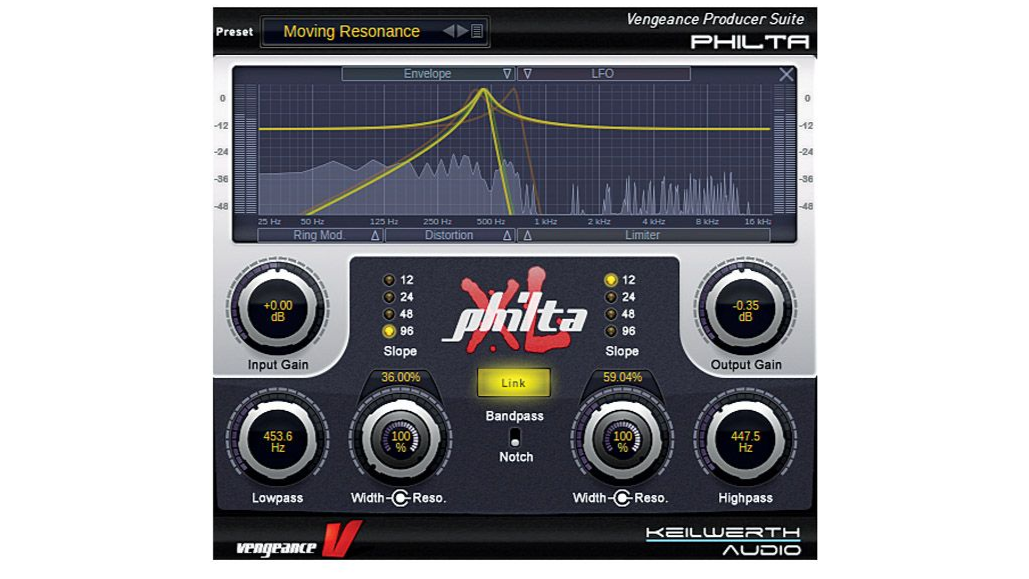
Specifications
Reasons to buy
Reasons to avoid
Another oldie, but goodie, Vengeance-Sound Philta XL has been a dance music favourite for over a decade. The overall design is pretty straightforward. The front panel shows the frequency spectrum in the main window, with two separate but linkable filters: one low-pass and one high-pass.
There are intuitive envelope and LFO controls, a ring modulator section, a distortion effect - fit for anything from all-out sonic decimation to helping sounds cut through a mix - and an output limiter. An LFO offers a range of shapes and speeds, can be sync'd to the host BPM and can be used to modulate a variety of parameters.
In terms of sound, Philta is excellent. It offers a great level of crunch and bite, and though it's not particularly warm in a 'vintage' way, it has bags of character and is perfect for modern productions.
Philta XL is a fantastic plugin that totally lives up to its heavyweight name. This filter is more than powerful and tasty-sounding enough to justify its purchase.
Read the full Vengeance-Sound Philta XL review
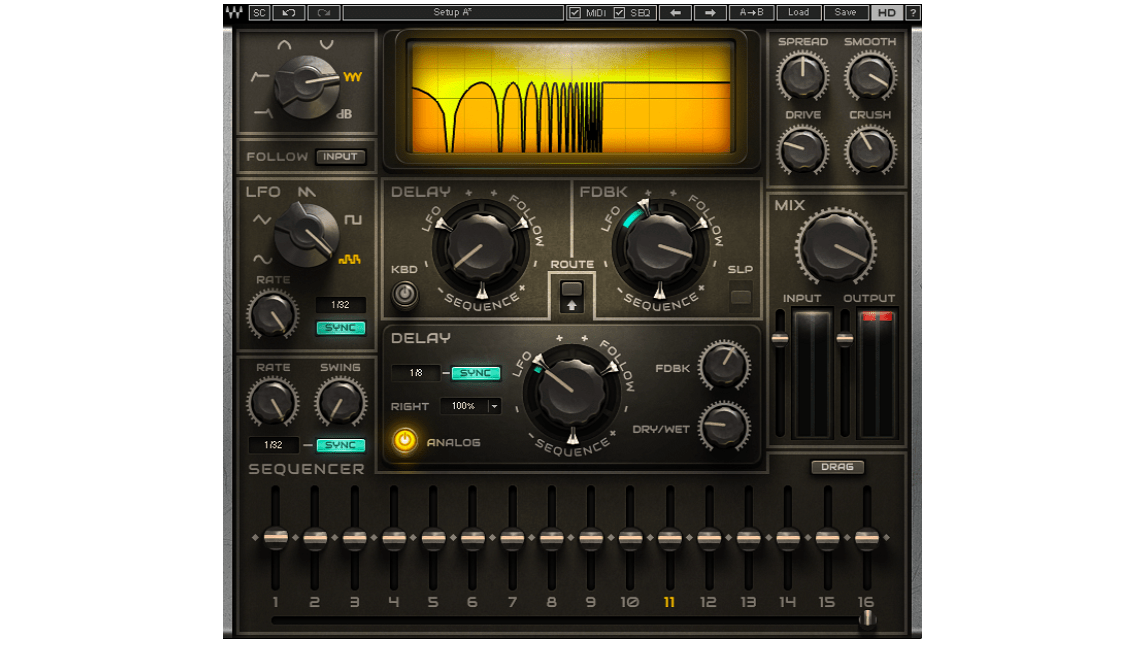
10. Waves MetaFilter
Our expert review:
Specifications
Reasons to buy
Reasons to avoid
Don’t let its vintage-style GUI fool you; MetaFilter is a plugin aimed squarely at the modern producer. Thanks to its well-implemented modulation tools, built-in effects and handy sidechain input, what MetaFilter really excels at is creating the sort of exaggerated sweeps and pumping effects that are ubiquitous in modern club music.
MetaFilter is built on a virtual analogue filter that can be switched between six modes. Beyond this, it features a handful of effects and global parameters, the most prominent of which is the Delay section. This can be switched to Analog mode, which emulates vintage delay hardware.
MetaFilter uses the same Virtual Voltage technology that featured in Waves’ Element synth, and the sound it delivers has plenty of warmth and character to it - a cut above most other filters in our plugins folder, certainly. The well-thought-out modulation section and quality delay make MetaFilter a fantastic tool for quickly sculpting wild filter effects.
Read the full Waves MetaFilter review
Best filter plugins: Buying advice
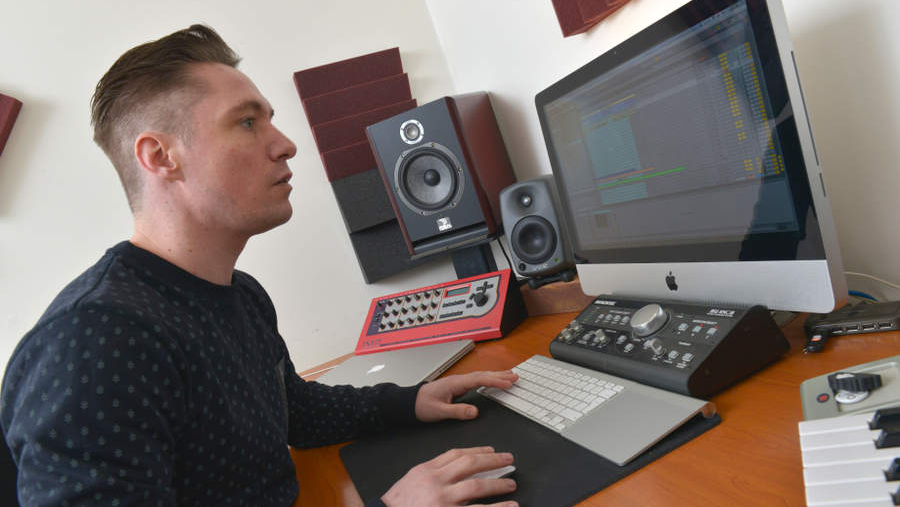
What is a filter plugin?
A filter is exactly what it says on the tin: a process applied to audio to 'filter' out certain parts of a frequency range or allow others to pass through. A high-pass filter, for example, scoops out the low frequencies and allows the high ones to pass; a low-pass filter does the opposite. A band-pass filter allows a certain bandwidth of frequencies through while a notch filter attenuates or removes a certain range of frequencies.
The main filter control is the cutoff frequency - where the low- or high-pass action takes place. High-pass filters allow all frequencies above the cutoff to pass; low-pass filters allow everything below to pass through.
The other important filter control is resonance. Less easy to understand, this is essentially a boost of the frequencies around the cutoff frequency. Adding resonance at this point increases the emphasis and drama of the sound. Add it as you sweep through on a low-pass filter and it adds a more dramatic swirling effect. Sweeping through cutoff and resonance controls on a filter has become a staple dance music effect - see more below.
The filter is the core ingredient of an EQ plugin and there is some crossover between the plugins we have included above and the best EQ Plugins listed elsewhere. However, the broad difference between filters and EQs is that filters can be more creative, extreme and can add more modulation and character, so can often deliver way more dynamic movement and extreme analogue saturation. You'd typically use an EQ to subtly enrich a track or stereo mix, whereas a filter might be used to deliver the kind of full-on, in your face effects so prominent in club music.
For dance music, for example, on a very basic level, the filter can be used to sweep through a club mix using a low- or band-pass effect to gradually and dynamically raise certain frequencies within the beats, bass, vocals, pads or even the entire mix. Think of a typical build/drop - the filter provides that dramatic build on some or all parts of the mix. Or apply a dramatic filter to a bass sound to create some of the most twisted sounds used in bass-heavy music. As such, many of the filters in our buyer's guide have become firm favourites with dance music producers over the years. Indeed, this also explains the longevity of some of our choices; FilterFreak and Volcano have been with us for the best part of two decades!
Your choice between using a filter and an EQ, then, lies in how creative and extreme you want to get with your frequency processing. Generally, the more creative you want to be, the more you should lean towards buying a filter, although you can get very creative with some EQs as well.
What are the different filter types?
As we have detailed, the main filter types are high- (HPF) and low-pass (LPF). Set your cutoff frequency with either type at, say, 500Hz and the HPF will allow everything above 500Hz to pass; the LPF allows everything below 500Hz to pass.
Band-pass filters
Band-pass filters allow a set range of frequencies to pass, so you can set the width and the slope of this range to very narrow and steep (using a high Q factor) to home in on very specific ranges to allow through. Do the same with a notch filter to surgically remove narrow frequency bands - great for removing glitches or noise from a mix.
Shelf filters boost or attenuate larger bandwidths of frequencies and look, you guessed it, like a shelf on the UI of a parametric EQ. These are used for wider but more subtle boosting or cutting of frequency ranges, not so much as creative effects (like a narrow notch or band-pass), but typically to brighten or darken a mix in a less dramatic fashion.
Dynamic and creative filters
More recent filter plugins have introduced modulation into the effects process, so parameters within the filter can be controlled by envelopes, step sequencers, LFOs and a lot more. This raises the bar from the typical filter sweeps we mention above, so it's not 'just' your typical filter frequency or resonance controls that are recorded or automated. Now filters have become modulation monsters with everything from those typical filter parameters to full-on analogue saturation or distortion being modulated by a range of sources. Filters have become characterful beasts, either creating the sound of classic hardware synths (see Arturia) or a sound all of their own with colour, distortion, delays and more pushing the humble filter into the world of the multi-effect.
It's fair to say, then, that while the best filter plugins use filtering as their base ingredient, most go a lot further, taking your creativity as far as your imagination allows.
Free filters
As with all plugin effects, you don't have to spend a fortune on filter plugins, and we have included filters across a wide range of prices. There are also free filters available; our favourites of these include TAL-Filter-2, the simple but effective AudiThing Filterjam, Ohmforce Fromage and The FilterBank plugin by Wolfgang Krumme.
Read more about how we test music making gear and services at MusicRadar.
Related buyer's guides
MusicRadar's got your back
- These are the best beginner DAWs
- Our guide to the best budget PCs for music production
- Check out the best DAWs for guitarists
- Take a look at the best audio interfaces
- Tweak your mix with the best studio monitors
- The best MIDI keyboards
- Try out the best microphones for recording
Want all the hottest music and gear news, reviews, deals, features and more, direct to your inbox? Sign up here.
Andy has been writing about music production and technology for 30 years having started out on Music Technology magazine back in 1992. He has edited the magazines Future Music, Keyboard Review, MusicTech and Computer Music, which he helped launch back in 1998. He owns way too many synthesizers.
